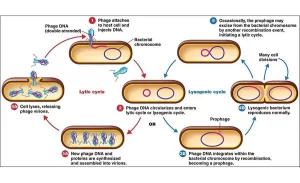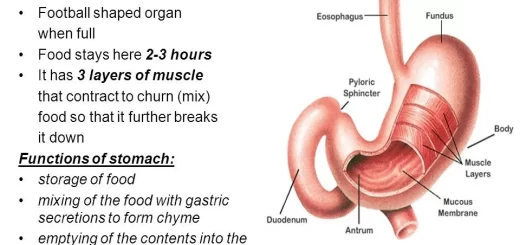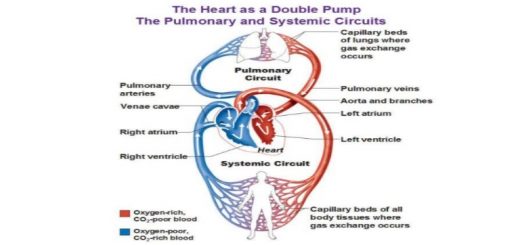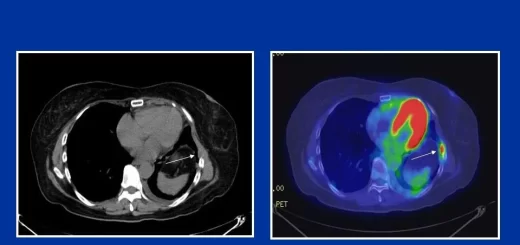Viral replication cycles, Importance of bacteriophages, Bacteriophage lytic and lysogenic cycles
Viruses multiply only in living cells. The host cell provides the energy, synthetic machinery, and low molecular weight precursors for the synthesis of viral proteins and nucleic acid. The viral genome contains the information necessary to cause the infected cell to synthesize virus-specific macromolecules required for the production of viral progeny.
Viral replication
Soon after interaction with a host cell, the infecting virion is disrupted and its infectivity is lost. In some cases, as soon as the viral nucleic acid enters the host cell, the cellular metabolism is redirected exclusively towards the synthesis of new virus particles, and the cell is destroyed. In other cases, although the cell synthesizes viral proteins and nucleic acids, its metabolic processes are not altered significantly, and the cell is not killed.
The virus-cell interaction may end in:
- Productive infection: occurs in permissive cells (able to support viral replication) and results in the production of new progeny virus.
- Abortive infection: No infectious progeny is produced either because the cell may be nonpermissive or because the virus may be defective.
- Latent infection: No or few viral genes are expressed, the viral genome persists in the surviving host cell.
General steps in viral replication cycles
1- Recognition and attachment to the host cell
The first step in viral infection is the interaction of the virus with a specific receptor site on the surface of the cell. The binding of the viral attachment proteins (VAP) on the outermost surface of the virion to a specific receptor on the host cell determines which cell can be infected.
Thus, it is the main determinant of tissue tropism (susceptible target cell eg. liver cell, nerve cell) and host range (restriction of infection to certain species eg. human, mouse). This attachment is achieved when specific proteins (VAP) on the viral capsid (in naked viruses) or viral envelope (in enveloped viruses) interacts with receptors on the plasma membrane of the target cell.
2- Penetration and uncoating
After binding, the virus particle is taken up inside the cell, This may be accomplished either by direct penetration of virus particles across the plasma membrane, by receptor-mediated endocytosis or after fusion of the virion envelope with the plasma membrane of the cell.
Uncoating is the physical separation of the viral nucleic acid from the outer structural components of the virion, Nucleocapsids are delivered to the site of replication within the cell; the genome of DNA viruses is delivered to the nucleus (except for pox viruses) while that of most of the RNA viruses remain in the cytoplasm where they replicate.
3- Macromolecular synthesis or eclipse phase
The eclipse phase is one of intense synthetic activity as the cell is redirected towards the synthesis of virus-related structures. At this step, specific mRNAs are transcribed from the viral nucleic acid, followed by the translation of mRNA to viral proteins using cell components.
The machinery of transcription and mRNA processing is found in the nucleus. Most DNA viruses (except Poxviruses) use the cell’s DNA-dependent RNA polymerase to synthesize mRNA, Eukaryotic cells lack enzymes able to synthesize mRNA off an RNA template, thus RNA viruses must encode the necessary enzymes for their transcription and replication. It has been found that single-stranded RNA viruses are either:
Negative sense viruses: their single-strand RNA genome is complementary to mRNA, which is conventionally designated positive strand. These viruses carry their own RNA polymerases to synthesize mRNAS.
Positive sense viruses: have a polarity similar to that of cellular mRNA and can be used directly as a template for transcription and translation. Transcription and translation occur in the following stages:
- Early transcription and translation which result in the formation of early proteins (Nonstructural proteins); the polymerases and regulatory proteins.
- Late transcription and translation which result in:
- Replication of the viral nucleic acid.
- Formation of the late proteins which include: structural proteins, enzymes carried by the newly formed virions, and proteins to effect release from the cells. Some viruses synthesize large polyprotein precursors that must be cleaved by viral and cellular proteases to generate functional proteins. Some viral proteins require posttranslational modifications such as phosphorylation or glycosylation.
4- Morphogenesis (Assembly of the virus)
Newly synthesized viral genomes and capsid polypeptides assemble together to form progeny viruses.
5- Release
Naked viruses are generally released after the lysis of the cell. Release of most enveloped viruses occurs after budding from the plasma membrane (but may involve other membranes in the cell). Virus envelope glycoproteins are inserted into cellular membranes; the assembled nucleocapsids then bud through the membranes at the modified sites and in doing so acquire an envelope.
Reinitiation of a Replication Cycle (i.e. spread of infection)
The virus released to the extracellular media is responsible for initiating new infections ie infection of surrounding cells or other susceptible hosts. However, initiation of new infections could be also achieved by:
- Cell-to-cell fusion i.e. multinucleated cell formation (syncitia) e.g. paramyxoviruses.
- Vertical transmission of the genome to daughter cells. eg retroviruses.
These routes allow the virus to escape antibody detection.
Bacteriophages
Bacteriophages are bacterial viruses with a DNA or RNA genome surrounded by a protein shell, Bacteriophages occur in more than 140 bacterial genera and in many different habitats, They can survive outside the bacterial host cell and can be transmitted from one cell to another.
Morphology
A classical phage consists of a head and a tail structure:
- Head: polyhedral in shape, tightly packed with nucleic acid (DNA or RNA, ss or ds) surrounded by a protein coat or capsid.
- Tail: consists of three parts, a hollow core with a contractile sheath (syringe-like structure) and a terminal base plate to which fibres of attachment are linked.
Phages can be distinguished on basis of their mode of propagation into:
- Lytic phages: produce many copies of themselves as they kill their host bacterial cell e.g. The T-even phages.
- Temperate phages: can enter a nonlytic prophage state in which replication of their nucleic acid is linked to replication of host cell DNA.
- Prophage: It is the phage genome that is present inside the bacterial cell in a stable heritable form and that reproduces synchronously with the host cell.
Replication of phages (lytic cycle)
- Adsorption occurs with the tail that mediates viral attachment and enables the phage to adsorb to the susceptible bacterial host cell (determines susceptibility).
- Penetration: the phage nucleic acid is injected into the periplasmic space of the host cell, through the rigid cell wall that has been weakened by the action of phage muramidase present on the base plate.
- Eclipse and assembly stages are similar to those occurring in animal viruses.
- Lysis and liberation of new phages: occur via cell lysis.
When temperate phages infect susceptible bacterial cells, they can either: Replicate and produce a large number of phages, releasing them into the extracellular environment following cell lysis i.e. lytic infection, or the Phage genome becomes integrated into the bacterial chromosome without killing the host and is then called prophage i.e. lysogenic state or lysogeny.
Lysogenic bacteria is the bacteria that carries a prophage, A key feature of lysogeny is the repressor protein synthesized under the direction of the phage, which blocks detachment of the prophage and blocks the expression of other phage genes.
Effect of lysogeny
- Lysogenic conversion: where prophage can carry genes that lead to the production of novel proteins by the cell. For example, the production of toxin by Corynebacterium diphtheriae occurs only when it contains the prophage of bacteriophage ß, which codes for the toxin that is responsible for the disease.
- Transduction: a process of gene transfer in bacteria in which genes from a host cell (a bacterium) are incorporated into the genome of a bacteriophage and then carried to another host cell when the bacteriophage initiates another cycle of infection. In nature, pathogenicity islands are often transported by phages.
Importance and uses of bacteriophages
- Generalized transduction is useful in genetic mapping because the closer the genes, the more likely they can be co-transduced in the same fragment of DNA.
- Used in typing of bacterial species (phage typing).
- They have been approved by the American FDA for use in the food industry to kill potentially lethal bacteria e.g. Listeria monocytogenes bacteriophages are designed to be sprayed on ready-to-eat meat and poultry products just before they are packaged.
- A potential substitute for antibiotics to treat bacterial infection (phage therapy).
You can download Science online application on Google Play from this link: Science online Apps on Google Play
Features and classification of viruses, Defective viruses and Viral vectors used for gene therapy
Pathogenesis of bacterial infection, Classification of Pathogens and Bacterial virulence factors
Microbiology, Bacteria structure, types, Gram-positive bacteria and Gram-negative bacteria
Bacterial growth phases and Environmental factors required for bacterial growth




